Management of Large Oroantral Fistulas Caused by Medication-Related Osteonecrosis with the Combined Sequestrectomy, Buccal Fat Pad Flap and Platelet-Rich Fibrin
- PMID: 33584046
- PMCID: PMC7855103
- DOI: 10.1007/s12663-019-01278-x
Management of Large Oroantral Fistulas Caused by Medication-Related Osteonecrosis with the Combined Sequestrectomy, Buccal Fat Pad Flap and Platelet-Rich Fibrin
Abstract
Purpose: The aim of this retrospective study was to describe the efficacy of management of bisphosphonate-related maxillary osteonecrosis, which had resulted in an oroantral fistula formation, by performing sequestrectomy, platelet-rich fibrin (PRF) and buccal fat pad (BFP) flap.
Patient and methods: A total of 7 patients diagnosed with stage III maxillary medication-related osteonecrosis according to guidelines of the American Association of Oral and Maxillofacial Surgeons. All patients complained of persistent pain, swelling and purulent drainage with sinusitis. In order to keep the infection under control, the patients first received an antibiotic combination for 2 weeks. Then, sequestrectomy and bone debridement were performed under general anesthesia. After that, an antrectomy was performed via endoscopic sinus surgery in some cases. And the fistula was closed with BFP after or before the PRF application to the region depending on the size of the fistula.
Results: The fistula was successfully closed. After a mean follow-up of 16 months, no symptoms were seen in the patients.
Conclusions: The patients were successfully managed with a combined treatment consisted of sequestrectomy, PRF and BFP. We suggest that large defects arose from medication-related osteonecrosis of the jaw can be managed with such a combined approach in order to lessen the recurrence risk.
Keywords: Bisphosphonates; Buccal fat pad; Medication-related osteonecrosis of the jaw; Oroantral fistula; Platelet-rich fibrin; Sequestrectomy.
© The Association of Oral and Maxillofacial Surgeons of India 2019.
Conflict of interest statement
Conflict of interestThe authors declare that they have no conflict of interest.
Figures








Similar articles
-
Effect of buccal fat pad, platelet-rich fibrin (PRF) and buccal advancement flap in oroantral fistula closure.Bioinformation. 2024 Dec 31;20(12):1765-1768. doi: 10.6026/9732063002001765. eCollection 2024. Bioinformation. 2024. PMID: 40230945 Free PMC article.
-
One stage combined endoscopic and per-oral buccal fat pad approach for large oro-antral-fistula closure with secondary chronic maxillary sinusitis.Eur Arch Otorhinolaryngol. 2016 Apr;273(4):905-9. doi: 10.1007/s00405-015-3656-z. Epub 2015 May 26. Eur Arch Otorhinolaryngol. 2016. PMID: 26006724
-
[One stage combined endoscopic and per-oral buccal fat pad approach for large oro-antral-fistula closure with secondary chronic maxillary sinusitis].Refuat Hapeh Vehashinayim (1993). 2015 Jul;32(3):32-7, 68. Refuat Hapeh Vehashinayim (1993). 2015. PMID: 26548148 Hebrew.
-
Treatment of oroantral communication with Platelet-Rich Fibrin: A systematic review.J Stomatol Oral Maxillofac Surg. 2022 Oct;123(5):e367-e375. doi: 10.1016/j.jormas.2022.03.014. Epub 2022 Mar 19. J Stomatol Oral Maxillofac Surg. 2022. PMID: 35318134
-
Closure of oroantral fistula: a review of local flap techniques.J Korean Assoc Oral Maxillofac Surg. 2020 Feb;46(1):58-65. doi: 10.5125/jkaoms.2020.46.1.58. Epub 2020 Feb 26. J Korean Assoc Oral Maxillofac Surg. 2020. PMID: 32158682 Free PMC article. Review.
Cited by
-
Autologous platelet concentrates as adjuvant in the surgical management of medication-related osteonecrosis of the jaw.Periodontol 2000. 2025 Feb;97(1):287-307. doi: 10.1111/prd.12608. Epub 2024 Sep 30. Periodontol 2000. 2025. PMID: 39345044 Free PMC article. Review.
-
Treatment of Odontogenic Maxillary Sinusitis with the Use of Growth Factors in Advanced Platelet-Rich Fibrin for Immediate Closure of Oro-Antral Communication: A Case Report.Int J Mol Sci. 2024 Apr 14;25(8):4339. doi: 10.3390/ijms25084339. Int J Mol Sci. 2024. PMID: 38673924 Free PMC article.
-
Selecting the Best Surgical Treatment Methods in Oro-Antral Communications.Int J Environ Res Public Health. 2022 Nov 5;19(21):14543. doi: 10.3390/ijerph192114543. Int J Environ Res Public Health. 2022. PMID: 36361422 Free PMC article.
-
Adverse Event Profiles of the Third-Generation Aromatase Inhibitors: Analysis of Spontaneous Reports Submitted to FAERS.Biomedicines. 2024 Aug 1;12(8):1708. doi: 10.3390/biomedicines12081708. Biomedicines. 2024. PMID: 39200174 Free PMC article.
-
Use of platelet concentrates in oral surgery of patients with osteonecrosis: a scoping review.Braz Dent J. 2023 Mar-Apr;34(2):1-13. doi: 10.1590/0103-6440202305254. Braz Dent J. 2023. PMID: 37194847 Free PMC article.
References
-
- Ruggiero SL, Dodson TB, Fantasia J, Goodday R, Agbaloo T, Mebrotra B, O’Ryan F. American Association of oral and maxillofacial surgeons position paper on medication-related osteonecrosis of the jaw—2014 update. J Oral Maxillofac Surg. 2014;72(10):1938–1956. doi: 10.1016/j.joms.2014.04.031. - DOI - PubMed
-
- Bamias A, Kastritis E, Bamia C, Moulopoulos LA, Melakopoulos I, Bozas G, Koutsoukou V, Gika D, Anagnostopoulos A, Papadimitriou C, Terpos E, Dimopoulos M. Osteonecrosis of the jaw in cancer after treatment with bisphosphonates: incidence and risk factors. J Clin Oncol. 2005;23(34):8580–8587. doi: 10.1200/JCO.2005.02.8670. - DOI - PubMed
-
- Mast G, Otto S, Mucke T, Schreyer C, Bissinger O, Kolk A, Wolff KD, Ehrenfeld M, Stürzenbaum SR, Pautke C. Incidence of maxillary sinusitis and oro-antral fistulae in bisphosphonate-related osteonecrosis of the jaw. J Craniomaxillofac Surg. 2012;40(7):568–571. doi: 10.1016/j.jcms.2011.10.012. - DOI - PubMed
LinkOut - more resources
Full Text Sources
